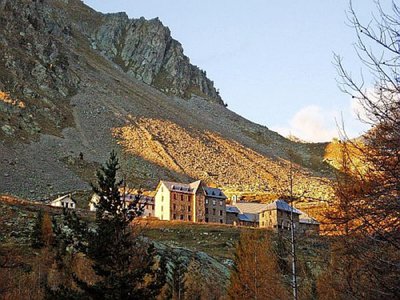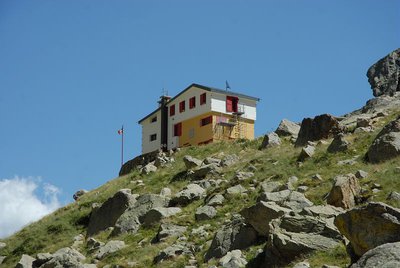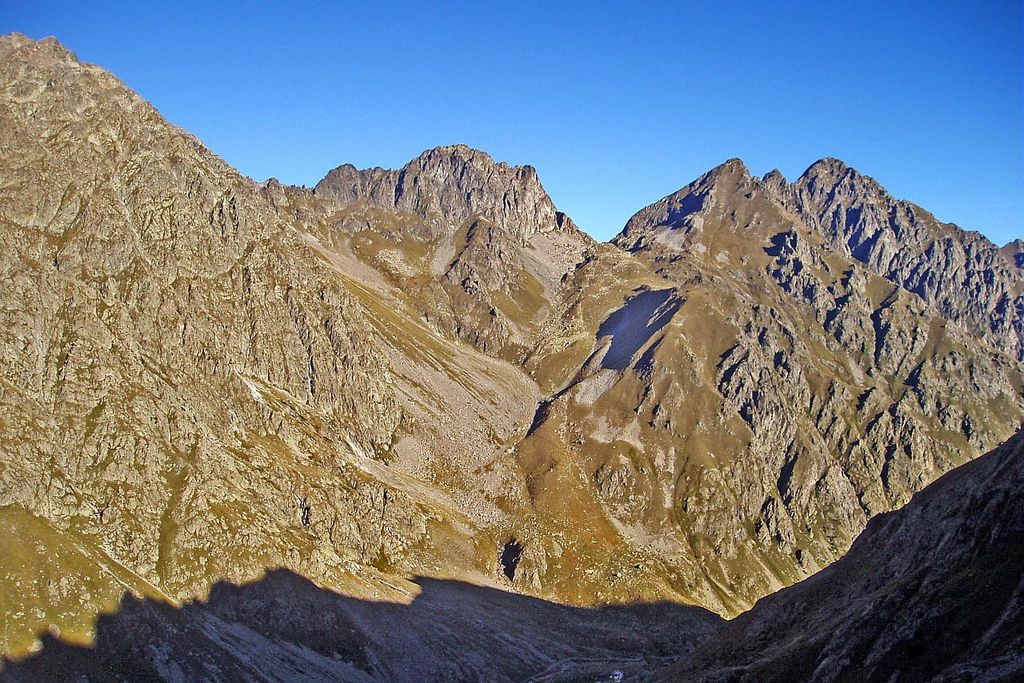
2. Grand Tour of Agentera and Vallée des Merveilles - Stage 2
15 points of interest

Il vecchio Rifugio Genova - Archivio EAM  Architecture
ArchitectureThe Genova Figari Refuge
To valorize the hiking trails along the Argentera Massif, in the last years of the nineteenth century the Liguria chapter of CAI decided to build a refuge near the upper Gias del Monighet, in the Vallone della Rovina. The Genova Refuge, as it was named, was inaugurated on 15 August 1898.
But the fate of the first refuge in the Maritime Alps was definitively sealed in 1968: the reservoir of the new Chiotas dam would submerge it permanently. ENEL assumed the task of building another refuge, which was inaugurated in 1981.
The refuge is named for Bartolomeo Figari, who as Secretary General of CAI saw both the successful conquest of K2 and the birth of the National Alpine Rescue Corps, to which he bequeathed all his worldly goods.
Praterie di alta quota - Cati Caballo  Flora
FloraThe cleared meadows
At the highest altitudes there are cleared meadows, the typical alpine pastures; they are composed of herbaceous species capable of covering soils normally closed to woody species, which, due to the very short vegetative period, cannot find suitable conditions for their development. Grazing by wild ungulates and, sometimes, by domestic sheep affects their composition, even if the most severe factor for species selection is represented by the climate.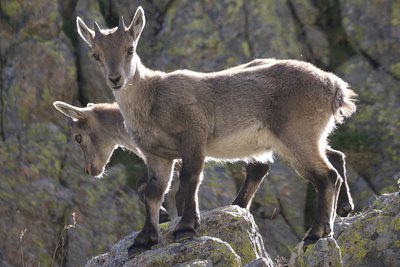
Giovani stambecchi al Colle di Fenestrelle - Roberto Pockaj  FaunaColle di Fenestrelle, as well as the surrounding area, is very popular with the ibex.
FaunaColle di Fenestrelle, as well as the surrounding area, is very popular with the ibex.
The Alpine ibex (Capra ibex), frequents alpine meadows and rock faces even above 3000 m, reaching the valley floor (provided it is not wooded) only in early spring, to be able to refresh itself after the long winter. Both sexes have annual growth horns, but much larger in males. The coat, light beige in summer, darkens to dark brown in winter.
Sedentary, grazing, it essentially feeds on grass, integrated with mosses, lichens and leaves of mountain shrubs, especially in winter.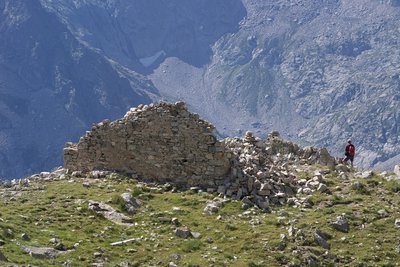
Il Ricovero Fenestrelle - Roberto Pockaj  History and historical trail
History and historical trailThe Fenestrelle shelter
The ruins near the pass mark the site of the Fenestrelle shelter, named for Lieutenant Angelo Bertolotti. Built in 1888 and in use until the Second World War, it could house a garrison of 10 on straw pallets. In their guidebook, entitled "La Valle Gesso", the Boggias indicate the shelter as being instead dedicated "to the memory of Angelo Bortolo, of the 1∞ Reg. of the Alpine Corps, who was killed on the Ortigara during the First World War".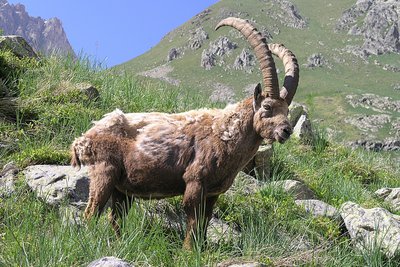
Stambecco maschio adulto, durante la muta primaverile del mantello - Roberto Pockaj  Fauna
FaunaThe Ibex of the Alps
Colle di Fenestrelle, as well as the surrounding area, is very popular with the ibex.
The Alpine ibex (Capra ibex), frequents alpine meadows and rock faces even above 3000 m, reaching the valley floor (provided it is not wooded) only in early spring, to be able to refresh itself after the long winter. Both sexes have annual growth horns, but much larger in males. The coat, light beige in summer, darkens to dark brown in winter.
Sedentary, grazing, it essentially feeds on grass, integrated with mosses, lichens and leaves of mountain shrubs, especially in winter.
 History and historical trail
History and historical trailThe Military Barracks at Colle delle Finestre and the other works of the Vallo Alpino
The barracks is a large building in stone and cement, still in decent condition, which was built to garrison the contingent tasked with defending the pass; its 16 rooms could house 50 men.
In addition to the barracks, other fortifications also defended the pass during the Second World War. On what is now the French side the remains of a nineteenth century shelter named for Lieutenant Mario Amedo are clearly visible, as are two bunkers of the Vallo Alpino defensive fortifications; 126 to the left of the pass and 127 to the right.
Pannello al memoriale della deportazione di Borgo S.D. - Archivio EAM  History and historical trail
History and historical trailTrails of Freedom
Between the 8th and 13th of September, 1943, just days after Italy's surrender, about twelve hundred Jewish civilians of all ages and walks of life, originating from Saint-Martin VÈsubie, crossed the Alps together with the Italian troops of the IV Army Corps. On foot, following two different routes, over the Colle di Finestra and the Colle di Ciriegia, the refugees arrived, respectively, in Entracque and Valdieri, where they were housed in the barracks and wherever else possible. A plaque affixed to the wall of the barracks at Colle di Ciriegia commemorates these events.
Giovani stambecchi al Colle di Finestra - Roberto Pockaj  Fauna
FaunaThe Alpine Ibex
Alpine ibex are a common sight at Colle di Fenestrelle and in the surrounding area. The Alpine ibex Capra ibex), a mountain goat, lives in Alpine meadows and rocky terrain, even over 3,000 meters, descending to the valley floors (if they are not wooded) only in the early spring, when the long winter's hardships make the new sprouts irresistible. Both sexes have horns that grow each year, but the males' horns are decidedly bigger. Their coats, a light beige in the summer, turn dark brown in the winter months.
A permanent resident, this grazing mountain goat subsists mostly on grass, in addition to some mosses, lichens and leaves of mountain shrubs, especially during the winter.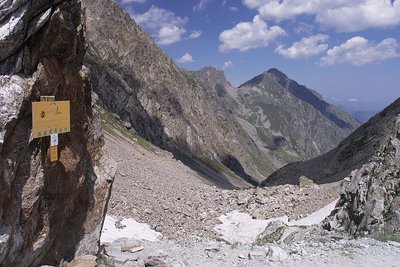
Colle di Finestra, panorama sul versante italiano - Roberto Pockaj  Cross-border
Cross-borderIl Colle di Finestra
The pass is a direct link between Valle Gesso and Vésubie, and has been crossed since time immemorial - and immortalized in legend and historical annals - by saints, emperors and invading armies. Before the Savoys gained direct access to the sea, the Colle di Finestra pass was also an important supply route for the salt trade.
Its name, which first appears in the written records in 1041, has remained unchanged up to the present day: Colle di Finestra or, as written on the military maps of the early 1900s, Colle delle Finestre. The first version is the right one, though, because it refers to a single natural window (Finestra) that splits the northwest crest of the Cayre de la Madone.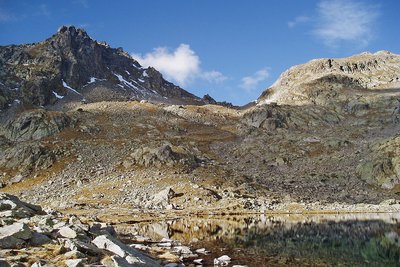
Lac, col et cîme ouest de Fenestre en automne, éclairage automnal. - Guigo Franck  Peak
PeakCol de Fenestre
A communication route within the House of Savoy, the col became part of Italian territory in 1860 and a border col in 1947, the date at which the border was moved to the watershed. When the weather is clear, the view extends beyond the plain of Pô to 200km to the north: Cervin (4478m) and Mont Rose (4634m) are visible in these conditions.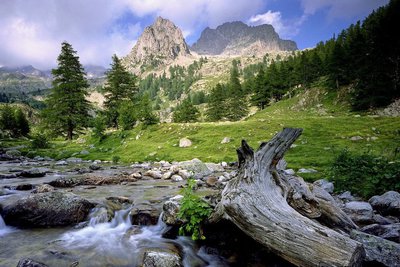
Vieille souche et portion de tronc de mélèze dans le torrent de la Madone de Fenestre face au Cayre de la Madone. - RICHAUD Philippe  History and historical trail
History and historical trailTerre de cour
The black rock marks one of the borders of the Terre de Cour, formerly a domain of the Count of Provence, before it was returned to the House of Savoy in the 14th century. Two inscriptions on the black rock provide a reminder of the past: “B” for Belvédère, “SM” for Saint-Martin-Vésubie. Terre de Cour was located exclusively in these two communes but they have to share the ancient rights to pasture and wood with Lantosque and Roquebillière.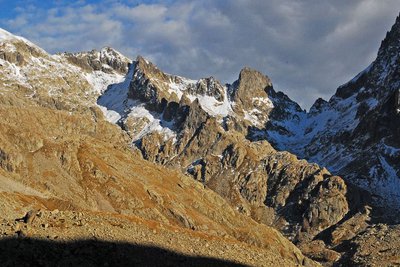
Dans l'ombre à droite le pas du mont Colomb, (2548 m). - GUIGO Franck  Geology
GeologyThe scars of erosion
When they converge, runoff streams of water leave the ground bare, breaking a fragile equilibrium. In addition, footfall due to tourism damages the ground and raises the question of preservation of natural environments. Plant cover has to be maintained as it protects the ground from erosion and guarantees its stability. Restoration work has been carried out to guide and direct the hundreds of hikers who love these wild areas.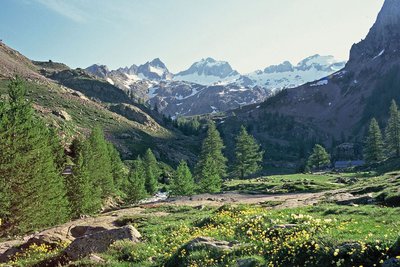
Le Gélas encore bien enneigé en fin de printemps, depuis le vallon de la Madone de Fenestre - LOMBART Guy  History and historical trail
History and historical trailCol de Fenestre mule track
This track has been used for a thousand years and was regularly maintained to allow mules transporting salt to pass with ease. The technique used to make and maintain these tracks involved self-locking stones. Identically sized slabs were arranged vertically in close lines. Fine materials were then used to hold it all in place. Gutters provided a run-off area for rainwater.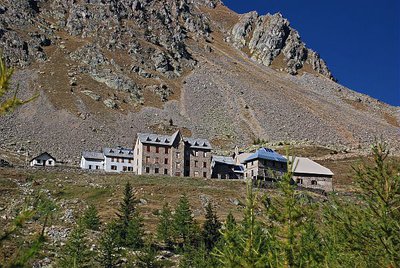
Depuis le vallon, le sanctuaire de la Madone de Fenestre en début d'automne - LEBOUTEILLER Eric  History and historical trail
History and historical trailLa Madone de Fenestre sanctuary
In the 8th century, a modest refuge already, providing accommodation for travellers. This sanctuary with its imposing forms was built by the Benedictines of Borgo San Dalmasso and destroyed by the Saracens in the 10th century. The Templars restored it in the 13th century shortly after the Virgin Mary appeared at the Grand Caire window. Subsequently, the sanctuary was devastated by fire several times and then rebuilt. Today it belongs to the diocese of Nice.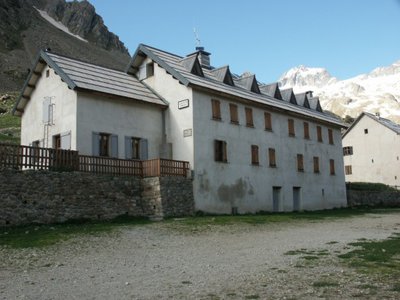
Refuge de la Madone de Fenestre - CAF / DR  Refuge
RefugeLa Madone de Fenestre refuge
Club Alpin Français
Capacity: 62 Possibility of eating and having a shower
Warden: Mid-June to late-September + school holidays and weekends in winter
Tel. 04 93 02 83 19
Out of season upon reservation: Patrick Miraillet: 04 93 03 91 02
Online reservations: http://chaletmadonedefenestre.ffcam.fr/
Useful numbers:
St-Martin-Vésubie Tourism Office: 04 93 03 21 28
Park House: 04 93 03 23 15
Description
As you leave the Genova refuge, turn left onto the track which heads along the shores of Bacino del Chiotas. Having gone over a mountain stream, turn right onto the path which begins with some stairways, following the white and red GTA Colle di Fenestrelle markers. Head upwards along some fine hairpin bends which head through grassy slopes until you reach a promontory at 2300 metres altitude; this is where the path heads downhill for a few metres (white and red markers supplemented with orange ones). After a valley, in which snow can remain late into the season (be careful), the climb comes to an end with a flatter section before the col and then rises to the right. Successively go through two permanent pools on the left and then on the right before you reach Colle Fenestrelle at an altitude of 2463 metres. Continue along the M11 path with red and white markers and you will initially reach a ruined building below the col before reaching a verdant flatter section at 2412 metres. Continue downhill along the pleasant path until you reach the bottom of the Gias Alve valley, below the Ellena Soria refuge, at an altitude of 1783 metres.
Head along the good path, which was formerly used as a route for pilgrims and as a salt road, heading upwards and south towards Col de Fenestre. Before reaching the col, you will pass by a former military barracks which marks the events of September 1943. This itinerary and this zone are ideal for seeing ibex.
From Col de Fenestres 2474m, head down the other slope along a good path. You will pass by several bunkers before reaching Lac de Fenestre 2250m, whose right shore you should head along. Subsequently, still following the well-landscaped path, head easily down to the bottom of the valley to reach the Madone de Fenestre refuge 1905m.- Departure : Genova refuge
- Arrival : Madone de Fenestre refuge
- Towns crossed : Entracque and Saint-Martin-Vésubie
Altimetric profile
Recommandations
Report a problem or an error
If you have found an error on this page or if you have noticed any problems during your hike, please report them to us here:
Close by3
- Mountain Hut
Mountain Hut
Rifugio Genova - Figari
The Genova-Figari refuge stands between two lakes: the Brocan, a natural alpine lake, and the artificial reservoir of Chiotàs, one of the largest in Europe. Easy to access, surrounded by meadows and the two lakes, it overlooks the walls of the peaks dell'Argentera, which with its 3300 m. it is the highest peak of the massif, and offers the opportunity to admire the numerous species of animals: ibexes, chamois, marmots, stoats, eagles, together with rare botanical species such as saxifrage florulenta, etc.

